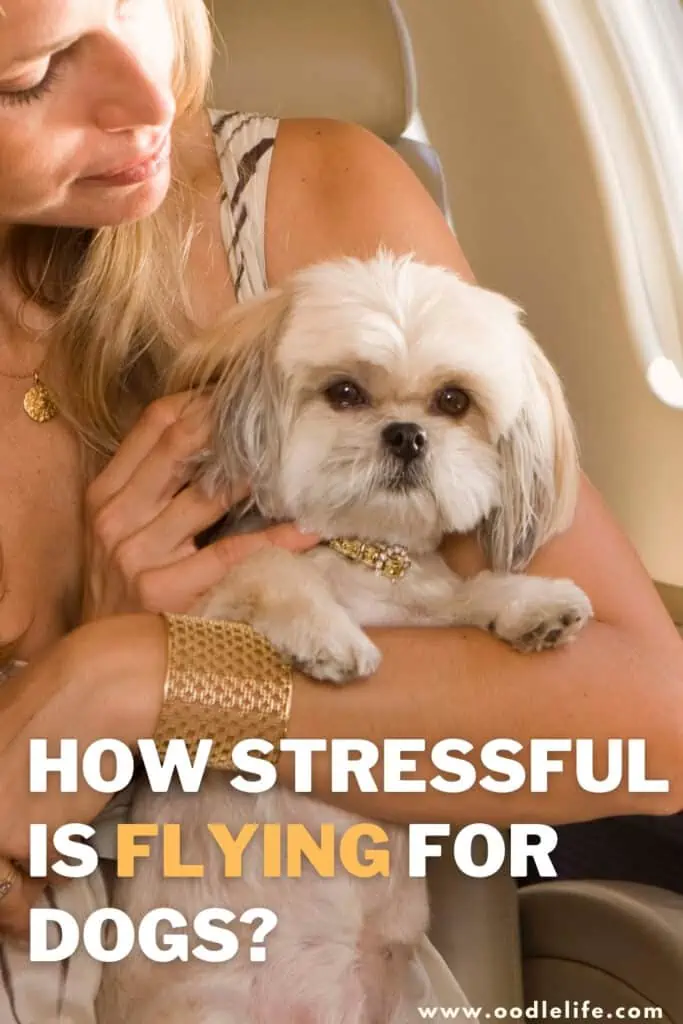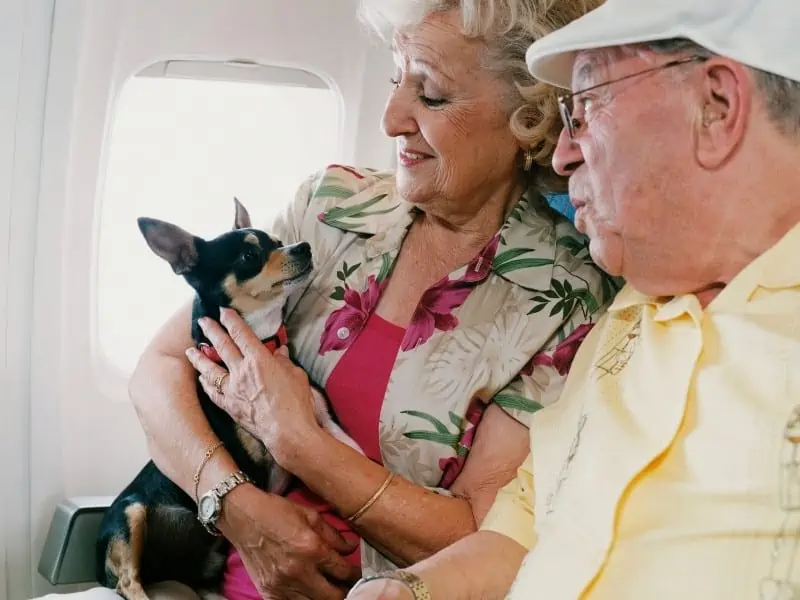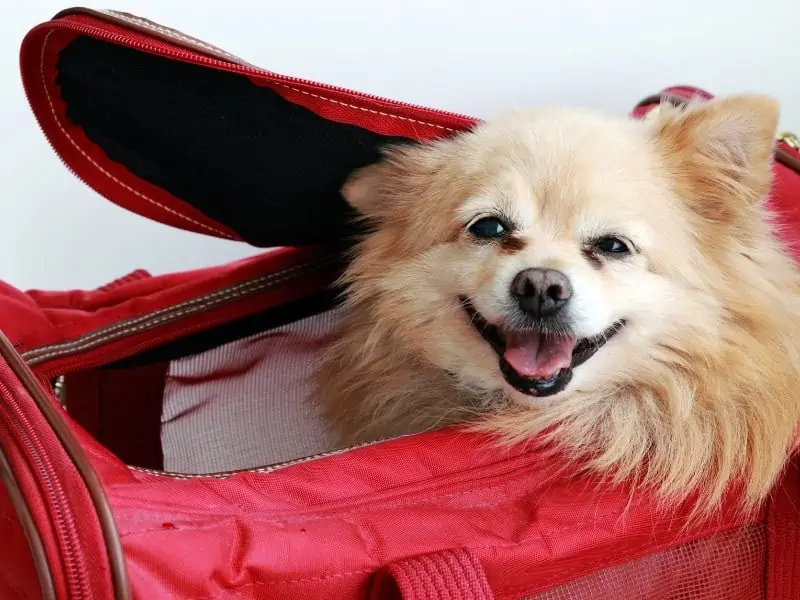How Stressful Is Flying For Dogs? [Calming Strategies]
Do you have a dog and are planning a vacation or trip that requires you to fly? Are you wondering whether to leave the dog behind with a friend or bring him along? If so, you must also wonder if your pup will get too stressed out when on a plane.
So, how stressful is flying for dogs? In this overview, we uncover whether a canine gets stressed out from flying and how you can reduce this stress. Here, you’ll learn about carrier training and how to tell if your dog is happy or sad.

Well then, how stressful is flying for dogs? Let’s find out!
What Makes Flying Stressful for Pups?
Being in a completely new environment can make dogs rather nervous. Furthermore, your dog may not enjoy sitting in a carrier and may get stressed out from the different people and voices on a plane.
Instead of being in a familiar situation, an airplane ride makes a dog nervous due to the strange noises, bright lights, and too many people. The changes in air pressure can also freak out a puppy. You may also find that dogs dislike any deviations in temperature. Therefore, bring a blanket or ask the airplane attendants for a blanket to keep your pup warm.

How to Minimize Stress for a Dog on a Plane?
If your canine is small enough, you should try to bring them on the plane as a carry-on animal. Otherwise, you’ll have to leave them as part of cargo travel. When a pup travels on the cargo side of a plane, she is much more likely to get stressed.
In such a case, they can hear the loud noises from the plane. They’ll also sit in an unfamiliar location without their beloved owners. This leads to stress and anxiety for any pet. You can find more than enough stories about dogs or other pets getting injured or sick during a cargo plane ride.
Specific Tips for Reducing Dog Flying Stress
Professional travel blogger Kevin of kevmrc.com shared two strategies he employs when travelling with a dog in cabin.
Frequent Traveller Tip 1: Using a Calming Low Voice
“I put my head down towards the carrier, and use a soft and calming voice to help reassure him that everything will be alright. This is essential during noisy times, such as taking off, landing, or when the cabin crew brings the refreshment cart down the aisle. I place my hand into the carrier, as gentle touches help calm my dog down.”
Frequent Traveller Tip 2: Booking a Window Seat Helps
“Flying with a dog is quite similar to flying with a young kid. You’re often given the middle seat, but I always prefer the window seat if I can because this offers fewer disturbances. Most airlines only allow a limited number of dogs per flight, so I make sure I have priority and choose my seat wisely.”
“I want to make sure my dog doesn’t see or hear anything that can make him bark, and the chances of those risks are reduced the further away from the gangway I am.”
Along with bringing your dog along as a carry-on, you should also pursue carrier training.
The Importance of Carrier Training
With the help of carrier training, a dog’s level of stress will decrease when taking a canine on an airplane. You should begin training your dog about two months before the first flight you take your pup on. Here’s what you need to do: put your dog in a carrier for an hour or two per day.
You can also leave your dog in a room by himself for half an hour or more each day.
An excellent idea is to leave some toys and treats inside a carrier. The treats will get your dog interested in sniffing and seeing what’s inside the carrier. Make sure that the airline also approves the carrier you’re using.
Walk around the house holding the carrier while your dog is inside.

Do Dog’s Ears Pop on the Plane?
At high altitudes on an airplane, a dog’s ears can pop. You might find your own ears popping, and your pup might feel uncomfortable due to its popped ears.
You can help your dog with the pain in their ears by bringing chew toys for them on the flight. The lower amount of oxygen can also cause your dog to get sick, but this is very rare. Essentially, if your dog seems to have hurt ears, then you should try rubbing their head and behind their ears to alleviate the pain.
Why A Calm Dog Is VITAL On Flights
I asked expert animal lawyer Kristina Bergsten Esquire (of The Animal Law Firm) for aviation specific advice. She stressed the vital importance of a well behaved and desensitized puppy.
What can you do if your dog whines on a plane?
“It is very likely that, under the ACAA, a dog who barks, whines, urinates, growls, or misbehaves in any way will be deemed NOT a service animal by the airline attendants, and the person who claimed the animal was a service animal will likely face fines and penalties for misrepresenting a service animal upon landing.”
What can you do if your dog barks on the plane?
“The better question to ask is: what can you do to prevent your dog from barking on the plane? With the recent explosion and confusion over Emotional Support Animals and their admittance on to planes and causing disruptions, airlines and the federal government are a lot more strict about what animals can and cannot come on planes.”
“As of 2020, ESAs are no longer allowed on planes, and only dogs can be service animals (formerly, miniature horses could be deemed service animals, but that is no longer the law). So, the best thing to do before getting on a plane with your service dog is make sure your dog is properly trained to handle sitting still and quietly for long periods of time in small spaces.”
How to Tell If Your Dog is Upset?
Are you concerned your dog is sad or upset? There are multiple signs you should pay attention to. For example, a dog might not eat his typical food as much when he’s upset or depressed.
Also, canines may go into hiding when they’re sad.
Your dog might act less friendly and playful. Does it look like your pup isn’t playing with her toys in the carrier or even eating her treats? Then she might have gotten upset.
Is Your Dog Sad?
Check out your pup’s body language to see if she’s feeling sad. For example, does Spot or Fluffy sleep more than usual or lick paws too much?
Do your dog’s ears flop down, and are his eyes looking sad? These are typical signs that your canine is feeling depressed or sad. Also, pay attention to how much your canine eats.
A pooch who doesn’t eat as much is usually feeling upset.

Is Your Dog Calm and Happy?
A calm and happy dog looks relaxed with a slightly open or loosely closed mouth. His tail should be upright, and you will see the tail wagging sometimes. A wagging tail can also mean excitement.
If your dog sleeps with his paws upward, then he’s happy. This is the most vulnerable position for sleep, which means your pooch feels safe and joyful.
Also, pay attention to their body language to see if they look confident and relaxed. All these signs show a happy pup.

Is Your Dog Angry?
Angry dogs can start growling, showing their teeth, and licking their lips when there’s no food in front of them. An angry dog may walk away from you, have a stiff body, or turn away. Their ears may flatten, and these dogs might start yawning.
You will definitely want to keep your dog comfortable and happy on an airplane ride, as an angry dog may cause problems for other passengers on the plane. Nobody wants to hear a growling, barking, angry dog when they’re trying to nap on a flight.

Making Sure Your Dog Is Comfortable on a Plane
You should make sure the carrier is large enough for your dog to stay comfortable during long and short flights. Bring chew toys, treats, and a comfy blanket on the plane. Make sure your dog has enough water ahead of time to stay hydrated.
Also, if your pup looks like she needs more air, you can try taking her out of the carrier for a few minutes. Whatever it takes to keep her comfortable while on the flight is fair game. After all, it should keep her from getting upset, angry, or even sick.
Essentially, you can manage and reduce the stress level of your dog when you go on a plane ride. Try to get your dog comfortable enough to take a long nap during the flight. That way, you won’t need to worry about the pup’s stress level, and you’ll both get back on land in no time.
Wrap Up
How stressful is flying for dogs? It can get stressful. However, there are specific steps you can take to better manage that stress and keep your dog happy and relaxed.
